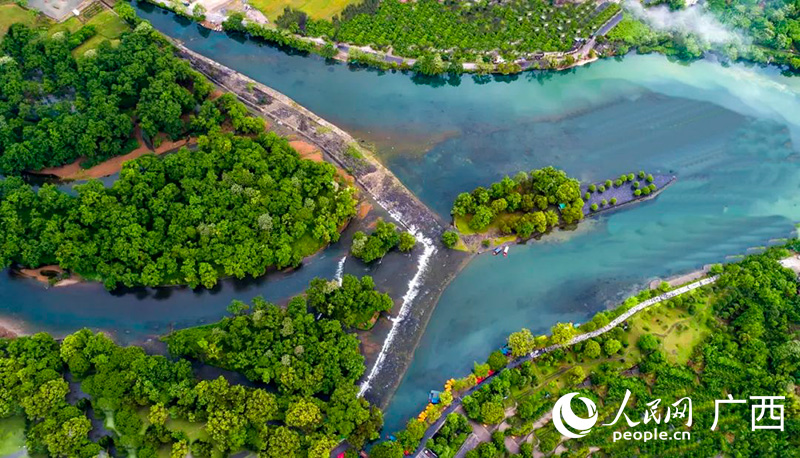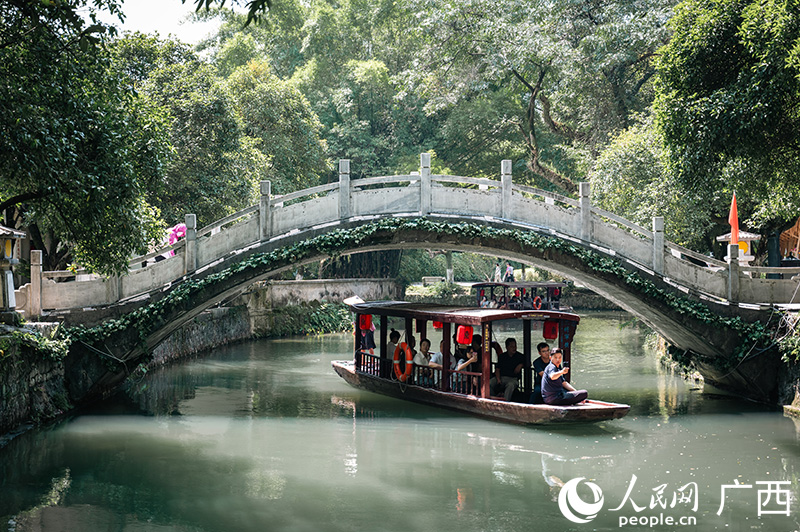




- BRNN
- BRI News
- BRNN News
- Database
Official Documents Polices and Regulations
Inter-government Documents International Cooperation BRI Countries
Business Guide Economic Data BRI Data
Trade
Investment Projects Latest projects
Cases - Content Pool

Photo shows a dam on the ancient Lingqu Canal in Xing'an county, Guilin city, south China's Guangxi Zhuang Autonomous Region. (People's Daily Online/Yan Lizheng)
Lingqu Canal, an ancient artificial canal in Xing'an county, Guilin city, south China's Guangxi Zhuang Autonomous Region, is driving tourism growth after recent restoration efforts.
The artificial canal, constructed more than 2,000 years ago under Emperor Qinshihuang's orders, was strategically designed to link the Yangtze and Pearl River systems for military transport.
This engineering marvel enabled Qinshihuang to swiftly consolidate control over the region south of the Five Ridges, a watershed between the major river basins, facilitating his rise as China's first unified emperor.
Today, the millennia-old canal serves as a living heritage site, significantly boosting tourism in Xing'an county.

Tourists enjoy a boat trip on the ancient Lingqu Canal in Xing'an county, Guilin city, south China's Guangxi Zhuang Autonomous Region. (People's Daily Online/Yan Lizheng)
"Lingqu Canal is an ingenious waterway that originated for military purposes and was gradually perfected over more than 2,000 years into a comprehensive water conservancy project, integrating military, agricultural, irrigation, production and daily life functions," said Chen Xinghua, honorary president of the Lingqu Canal research association.
"The water gates on the Lingqu Canal are known as the 'world’s father of ship locks.' With these water gates, which function like modern ship locks, the Lingqu Canal became the world's first artificial canal to cut through mountains and ridges," Chen explained.
The 37-kilometer canal still serves boat traffic while providing irrigation, flood control and environmental benefits, Chen said.
The canal now irrigates 65,000 mu (about 4,333 hectares) across 186 villages in five townships of Xing'an county, serving more than 59,000 residents.
Farmers in the irrigation zone grow rice alongside cash crops, including grapes, citrus fruits and strawberries.

Photo shows a section of the ancient Lingqu Canal in Xing'an county, Guilin city, south China's Guangxi Zhuang Autonomous Region. (People's Daily Online/Fu Huazhou)
Xing'an county authorities, committed to preserving and revitalizing the Lingqu Canal, have implemented protective regulations, established the Lingqu Canal Museum and organized seminars for the World Canals Conference. These efforts aim to protect and promote the canal's cultural heritage while helping develop Guilin into a world-class tourist destination.
The canal's inscription on the World Heritage Irrigation Structures list in 2018 has significantly raised its international profile as it moves closer to achieving UNESCO World Cultural Heritage status.
Xing'an county has recently intensified its management of the Lingqu Canal water system through dredging, slope treatment, embankment reinforcement and water system connectivity improvements.
These efforts have restored the rural water systems' basic functions for ecological preservation, flood control, drainage and irrigation. The efforts have transformed villages along both banks of the canal, with more than 20 communities now recognized as model villages for their beauty and livability.
"We are striving to make the Lingqu Canal a beautiful 'calling card' for developing Guilin into a world-class tourist city," said Wei Yuanming, magistrate of Xing'an county, in an interview with People's Daily Online.
With a focus on securing UNESCO World Heritage status for Lingqu Canal, Xing'an county has prioritized ecological conservation, protection of the waterway and preservation of its cultural heritage, Wei noted. This approach has created a path for integrated cultural and ecological development, driving environmental, economic and cultural advancement in areas along the canal.

Tel:86-10-65363107, 86-10-65368220, 86-10-65363106